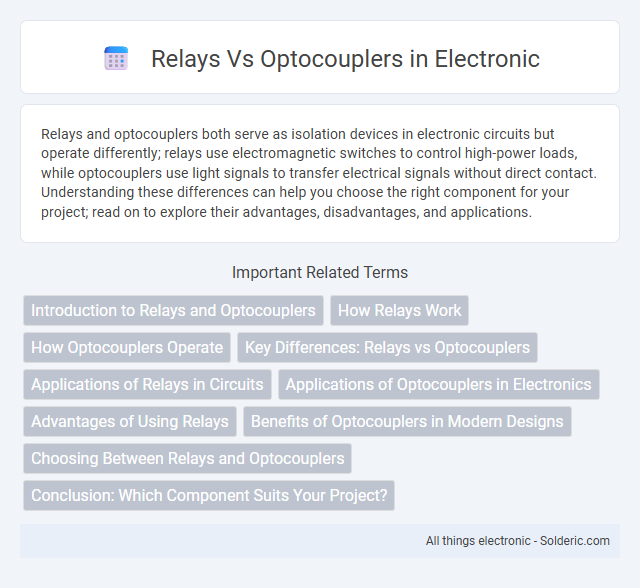Relays and optocouplers both serve as isolation devices in electronic circuits but operate differently; relays use electromagnetic switches to control high-power loads, while optocouplers use light signals to transfer electrical signals without direct contact. Understanding these differences can help you choose the right component for your project; read on to explore their advantages, disadvantages, and applications.
Comparison Table
| Feature | Relay | Optocoupler |
|---|---|---|
| Isolation Type | Magnetic | Optical |
| Switching Speed | Slow (milliseconds) | Fast (microseconds to nanoseconds) |
| Contact Wear | Mechanical wear, limited lifespan | No mechanical parts, longer lifespan |
| Voltage & Current Rating | High voltage and current capable | Low voltage and current, signal level switching |
| Size | Larger | Smaller and compact |
| Power Consumption | Higher coil current required | Low input drive current |
| Noise & EMI | Generates electrical noise during switching | Minimal noise, better EMI immunity |
| Typical Applications | Switching high power loads, industrial control | Signal isolation, microcontroller interface |
Introduction to Relays and Optocouplers
Relays are electromagnetic switches that control high-power circuits using a low-power signal, providing electrical isolation between input and output. Optocouplers use light to transfer electrical signals between isolated circuits, offering faster switching speeds and enhanced noise immunity compared to relays. Both components play critical roles in protecting sensitive electronics and enabling signal control in industrial and consumer applications.
How Relays Work
Relays operate by using an electromagnet to mechanically switch electrical contacts, allowing control of a high-power circuit with a low-power signal. When current flows through the relay coil, it generates a magnetic field that pulls the armature, closing or opening the contacts to connect or disconnect the load. This electromechanical action isolates your control circuit from the high-voltage output, providing electrical separation and protection.
How Optocouplers Operate
Optocouplers operate by using an LED and a photodetector to transfer electrical signals through light, providing electrical isolation between input and output circuits. The LED emits infrared light in response to an input voltage, which activates the photodetector on the output side, generating a corresponding electrical signal without direct electrical contact. This optical isolation effectively protects sensitive components from voltage spikes and noise in control systems.
Key Differences: Relays vs Optocouplers
Relays use an electromagnetic coil to mechanically switch contacts, providing galvanic isolation and high current handling, while optocouplers rely on light signals within a sealed package for electrical isolation and fast switching. Relays are suitable for high power applications due to their robust contacts, whereas optocouplers excel in low voltage control circuits with minimal signal distortion and no moving parts. The primary difference lies in mechanical switching versus optical isolation, impacting response time, durability, and typical use cases in electronic circuits.
Applications of Relays in Circuits
Relays are widely used in circuits for switching high-power loads, isolating different voltage levels, and controlling multiple circuits with a single signal. Your applications include automotive systems, industrial automation, home appliances, and telecommunications, where robust mechanical switching is essential. Unlike optocouplers, relays provide physical separation and can handle higher current and voltage demands, making them ideal for heavy-duty switching tasks.
Applications of Optocouplers in Electronics
Optocouplers are widely used in electronics for isolating different sections of a circuit to prevent high voltages from damaging sensitive components, making them essential in power supply regulation and microcontroller interfaces. Their fast switching capabilities and noise immunity enable reliable signal transmission in data communication and industrial automation systems. You can enhance circuit safety and performance by integrating optocouplers where electrical isolation and signal integrity are critical.
Advantages of Using Relays
Relays provide robust electrical isolation and can switch high voltage and current loads directly, making them ideal for controlling heavy-duty equipment. Their mechanical contacts offer clear on/off positions, which enhances reliability in power distribution and industrial automation. You benefit from their durability in harsh environments and compatibility with a wide range of electrical systems.
Benefits of Optocouplers in Modern Designs
Optocouplers offer superior electrical isolation by using light to transfer signals, reducing noise interference and enhancing the safety of sensitive components in modern circuits. Their compact size and fast switching speeds make them ideal for high-frequency applications, outperforming mechanical relays in reliability and longevity. You benefit from reduced electromagnetic interference and increased design flexibility when incorporating optocouplers into your electronic systems.
Choosing Between Relays and Optocouplers
Choosing between relays and optocouplers depends on factors such as voltage isolation, switching speed, and load type. Relays offer robust isolation and can handle higher current loads, making them ideal for switching AC devices or heavy electrical equipment. Optocouplers, on the other hand, provide faster switching speeds, compact size, and require less power, making them well-suited for isolating sensitive electronic circuits in your designs.
Conclusion: Which Component Suits Your Project?
Relays offer high current switching capabilities and electrical isolation suitable for controlling heavy loads or AC circuits, making them ideal for industrial applications. Optocouplers provide fast, low-power signal isolation useful in sensitive electronic systems and microcontroller interfaces requiring minimal interference. Choosing between relays and optocouplers depends on the project's voltage, current requirements, switching speed, and isolation level needed.
relays vs optocouplers Infographic

 solderic.com
solderic.com